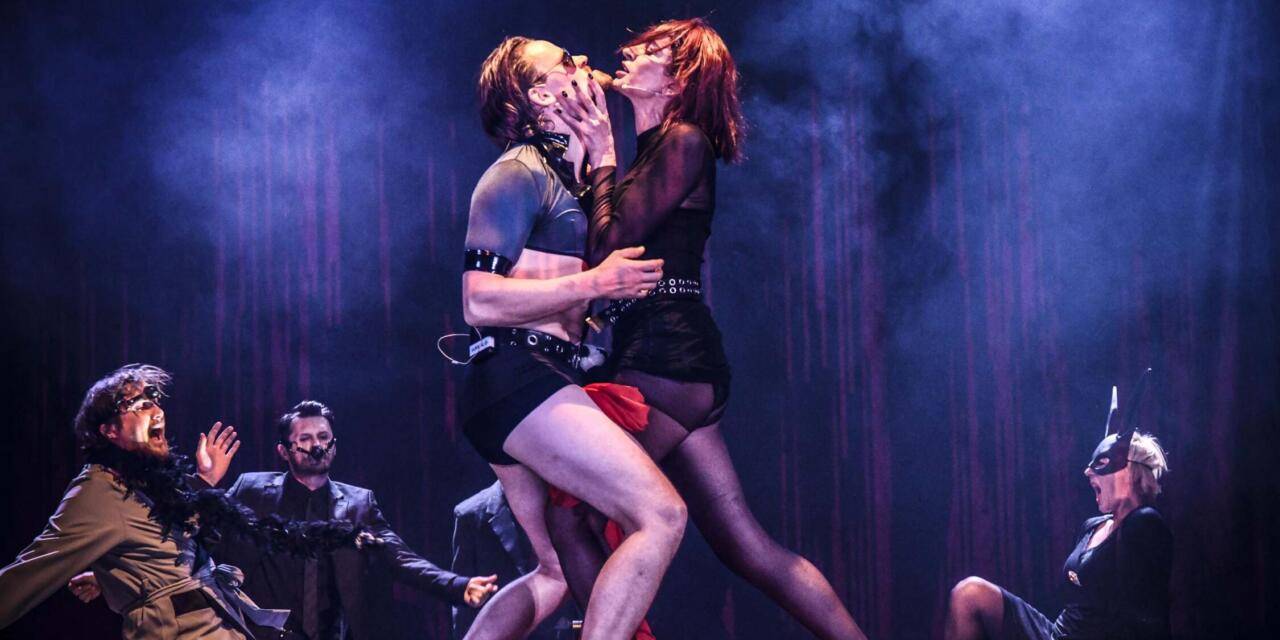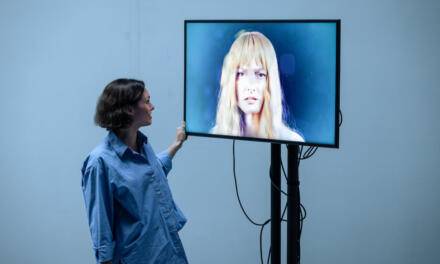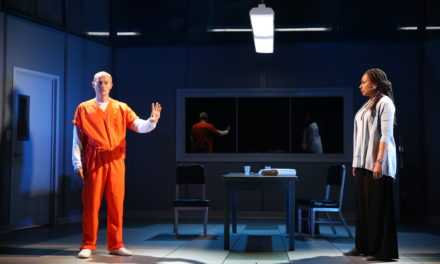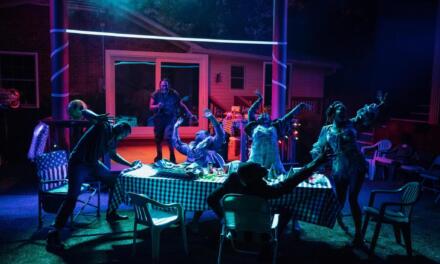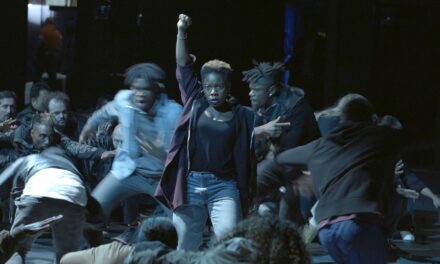There are wars, and then there are post wars, the kind of which take place around the negotiating table where political elites, both domestic and international, actors on a world stage, bargain for land, people and property. It is tactical pivoting in which the citizens of the countries involved rarely have a say.
After the wars in the Balkans, several negotiating processes took place and Jeton Neziraj’s newest work, Negotiating Peace, imagines and interrogates the processes involved in a post-conflict world between two made-up countries which are not unlike Bosnia, or Kosovo and Serbia. Chief US Diplomat in the peace process which ended the Bosnian War, Richard Holbrooke and his book about the Dayton agreement, “To End a War,” and Albanian writer Ismail Kadare’s fictional novel The General of the Dead Army, serve as guides and inspirations. To End A War details the trials of finding a resolution to the Bosnian conflict, while The General of the Dead Army is a fictional account of an Italian General returning to Albania after WW2 to retrieve the remains of Italian soldiers. What is served up, is a theatrical take on various ways of trying to achieve peace and an exploration of political theatrics, although comparing and contrasting the theatrics of politics alongside the vagaries of dramatic theatre is not new. Lucy Prebble’s A Very Expensive Poison sought to untangle what is labelled as Putinesque theatricality. It is even possible to study a module at university which interrogates the applicability of theatrical devices and their use in modern politics. And read any discourse from academics about the UN’s negotiating peace processes and one will instantly realise how theatrical the language is – negotiators are commonly referred to as actors.
Central to the conceit of this show is two ideas that have visual representation – that the negotiating table is both a theatrical stage for the expansion of the egos of the negotiators (to make them into superheroes and movie stars) and that it also symbolises a graveyard, where General Amadeus (Shkumbin Istrefi), one of the negotiators, searches for the bones of a dead colleague, the notorious Colonel X. From the beginning, the weight of all of the dead, the trauma that some of those dead inflicted on the still living, hangs over the negotiations like an unseen guillotine in Blerta Neziraj’s staging – even if the first scene, as labelled in the play text, is a scene from General Amadeus’ movie (a US film star promises to make a movie about him). And around the negotiators Maria (an activist, played by Ema Andrea), Madera (from the Republic of Banovina (Martin Kõiv,), Danielle (Republic of Unmikistan, (Eja Bavcic)) and the American like Holbrooke diplomat, Joe Robertson (Harold Thompson Rosenstrom), brought in to force a deal, are two civilians, representatives of the conflicting countries. Orest Pastukh is a security guard who watches the antics of the negotiators with increased puzzled bemusement whilst Melihate Qena as Marta, the room attendant, hides a trauma that is only released near the end of the play. Above the negotiating table is a circular mass of material. At times, this material is still, at other times it seems to move as a camera rotates below it, capturing it in close up. The impression it gives is of a life belt encircling the conference table as the negotiators bicker or as a symbol of a never ending sequence of events (peace processes) which have no end. War, as Jeton Neziraj has commented elsewhere, does not end when it finishes. And Kosovo, is free of war but has no peace ( a paper at the German Development Institute labels Kosovo as being partly free).And with more peace processes possibly on the horizon (Ukraine and Russia, and Israel and Palestine) – when and how will they all end?
The play does not have an answer. It can only suggest. Blerta Neziraj disrupts and disturbs the peace negotiations with cameras – yes they represent the eyes of the world watching these “actors” – but they also make the negotiators into stars, not least Robertson, who shouts and screams and cajoles down the camera as if he is in a Dogma film. Away from the unpleasant arguing and bargaining, symbolism is used to imply what is going on in their inner lives. At one point, they all line up in a urinal (Minus the security guard and the room attendant) and swing flags from between their legs – it’s clear that nationalism leads the way in the negotiating room, or are they, in their negotiations, pissing away their countries’s futures and dreams? It is left to the audience to decide. At another moment, Robertson and Maria gyrate and rub their bodies up and down each other on the conference table, in a direct reference to S&M. It is crude but the message is that those who are tasked with procuring peace have other drives motivating them – masochism and sadomasochism. The two partners here are entering a consensual entanglement where boundaries are clear and are playing – in much the same way that peace negotiators will play. This is further represented by Madera, who pleading down the camera for what he wants from Robertson, at first tries an aggressive approach, which he then switches to a more flirtatious one. However, S&M is not always about sexual gratification, it can also be about relieving stress – Blerta Neziraj leaves the audience to make up their own minds.
There are two points at which the real world interrupts this secret universe of peace negotiations. General Amadeus realises that he will be subject to a tribunal for war crimes and pees himself. He staggers comically around the stage with his trousers around his legs – is the audience meant to feel pity, sadness, or to mock? War crimes committed by Serbs against the Kosovo people are still young in their memories. His nastiness is also revealed when he interrogates Marta over the missing Colonel X, suspecting that she is responsible for his disappearance.
If the compulsion to make this show was to explore peace negotiations, then its conclusion is perhaps a surprising one. Negotiating peace cannot be done in a vacuum or a bubble, ignoring the citizens that it will most effect, bull dozing over their trauma. The dead and what the dead did to the living has a presence in this show from the beginning. They are the elephant (or perhaps the panda, seeing as Pastukh wears a waving panda costume at the beginning and end of the show, symbolising peace) in the room, yet conversely, recognising them is the only way to make proper peace. The presence of this trauma is realised by Marta . All the way through the show she is tight faced and wordless until what happened to her is startlingly revealed. And at this point, as she and the Security Guard embrace tightly, brought together through shared trauma, the material life belt is lowered down to the stage to reveal itself as a knitted structure of women’s garments. An estimated 20,000 women were raped during the Kosovo war by Serbian forces. Only one perpetrator has been prosecuted so far. 20,000 is only an estimate too. In Bosnia, Bosnian Serb Ratko Mladic was convicted of war crimes, including mass rape by his troops, but the survivors still live with the trauma twenty years on. Such crimes and traumas apply to ongoing conflicts today.
In conclusion, Negotiating Peace set out to explore the various peace negotiations that have taken place around the world. It has found a couple of important facts – that post-war Kosovo was abandoned by the EU in order to appease Serbia (Dr Aidan Hehir, an academic and writer who was invited onstage during the show, gave some factual evidence to nicely enunciate that) – that for peace to even begin to have a chance (whatever that looks like? because a country’s peace and that of its individuals might not be the same thing) the internal and external trauma suffered by the warring countries citizens must not only be acknowledged, but given a voice, with a view to bringing the criminals to justice. The end of the show is effective in communicating this. Whether actual politicians and diplomats will take note is another matter.
Negotiating Peace was performed as part of the Kosovo Theatre Showcase 2023. It is currently on tour in Europe. The play is dedicated to Canadian playwright Sharon Pollock.
This post was written by the author in their personal capacity.The opinions expressed in this article are the author’s own and do not reflect the view of The Theatre Times, their staff or collaborators.
This post was written by Verity Healey.
The views expressed here belong to the author and do not necessarily reflect our views and opinions.

